light BMW 550I SEDAN 2011 User Guide
[x] Cancel search | Manufacturer: BMW, Model Year: 2011, Model line: 550I SEDAN, Model: BMW 550I SEDAN 2011Pages: 304, PDF Size: 10.18 MB
Page 42 of 304
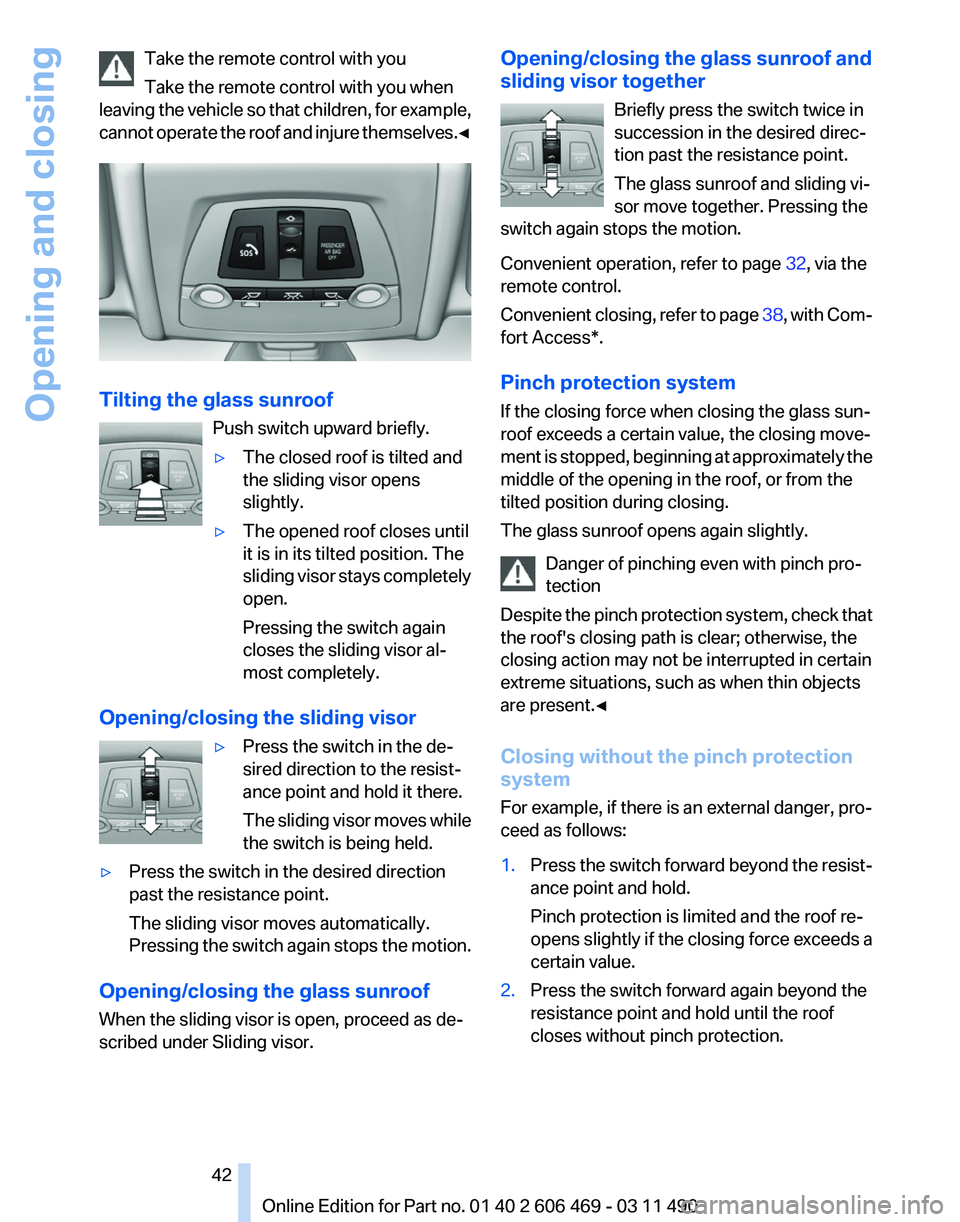
Take the remote control with you
Take the remote control with you when
leaving
the vehicle so that children, for example,
cannot operate the roof and injure themselves.‚óÄ Tilting the glass sunroof
Push switch upward briefly.
‚Ė∑The closed roof is tilted and
the sliding visor opens
slightly.
‚Ė∑ The opened roof closes until
it is in its tilted position. The
sliding
visor stays completely
open.
Pressing the switch again
closes the sliding visor al‚Äź
most completely.
Opening/closing the sliding visor ‚Ė∑Press the switch in the de‚Äź
sired direction to the resist‚Äź
ance point and hold it there.
The
sliding visor moves while
the switch is being held.
‚Ė∑ Press the switch in the desired direction
past the resistance point.
The sliding visor moves automatically.
Pressing
the switch again stops the motion.
Opening/closing the glass sunroof
When the sliding visor is open, proceed as de‚Äź
scribed under Sliding visor. Opening/closing the glass sunroof and
sliding visor together
Briefly press the switch twice in
succession in the desired direc‚Äź
tion past the resistance point.
The glass sunroof and sliding vi‚Äź
sor move together. Pressing the
switch again stops the motion.
Convenient operation, refer to page 32, via the
remote control.
Convenient
closing, refer to page 38, with Com‚Äź
fort Access*.
Pinch protection system
If the closing force when closing the glass sun‚Äź
roof exceeds a certain value, the closing move‚Äź
ment is stopped, beginning at approximately the
middle of the opening in the roof, or from the
tilted position during closing.
The glass sunroof opens again slightly.
Danger of pinching even with pinch pro‚Äź
tection
Despite the pinch protection system, check that
the roof's closing path is clear; otherwise, the
closing action may not be interrupted in certain
extreme situations, such as when thin objects
are present.‚óÄ
Closing without the pinch protection
system
For example, if there is an external danger, pro‚Äź
ceed as follows:
1. Press the switch forward beyond the resist‚Äź
ance point and hold.
Pinch protection is limited and the roof re‚Äź
opens
slightly if the closing force exceeds a
certain value.
2. Press the switch forward again beyond the
resistance point and hold until the roof
closes without pinch protection. Seite 42
42 Online Edition for Part no. 01 40 2 606 469 - 03 11 490
Opening and closing
Page 44 of 304
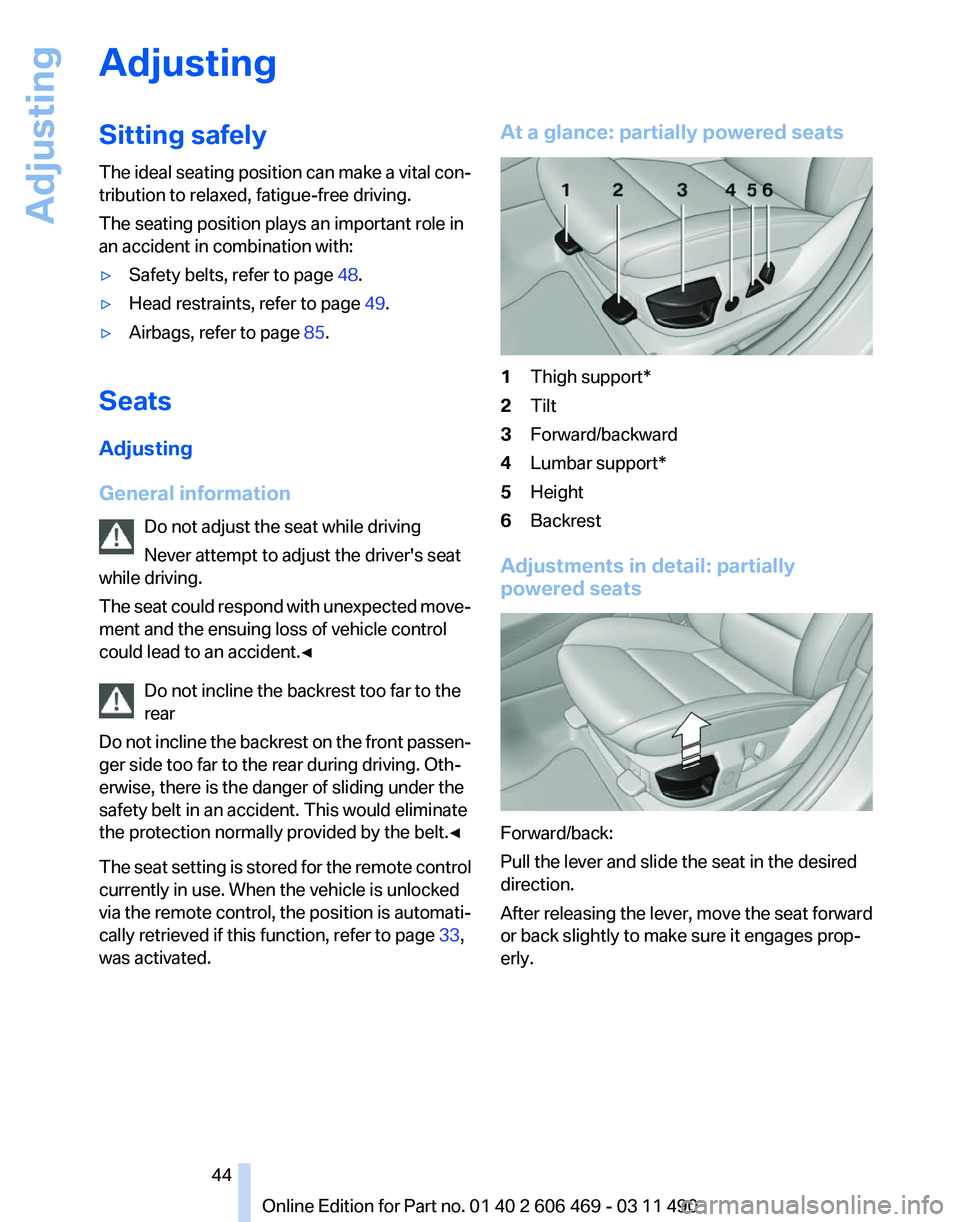
Adjusting
Sitting safely
The
ideal seating position can make a vital con‚Äź
tribution to relaxed, fatigue-free driving.
The seating position plays an important role in
an accident in combination with:
‚Ė∑ Safety belts, refer to page 48.
‚Ė∑ Head restraints, refer to page 49.
‚Ė∑ Airbags, refer to page 85.
Seats
Adjusting
General information Do not adjust the seat while driving
Never attempt to adjust the driver's seat
while driving.
The
seat could respond with unexpected move‚Äź
ment and the ensuing loss of vehicle control
could lead to an accident.‚óÄ
Do not incline the backrest too far to the
rear
Do not incline the backrest on the front passen‚Äź
ger side too far to the rear during driving. Oth‚Äź
erwise, there is the danger of sliding under the
safety belt in an accident. This would eliminate
the protection normally provided by the belt.‚óÄ
The seat setting is stored for the remote control
currently in use. When the vehicle is unlocked
via the remote control, the position is automati‚Äź
cally retrieved if this function, refer to page 33,
was activated. At a glance: partially powered seats
1
Thigh support*
2 Tilt
3 Forward/backward
4 Lumbar support*
5 Height
6 Backrest
Adjustments in detail: partially
powered seats Forward/back:
Pull the lever and slide the seat in the desired
direction.
After
releasing the lever, move the seat forward
or back slightly to make sure it engages prop‚Äź
erly.
Seite 44
44 Online Edition for Part no. 01 40 2 606 469 - 03 11 490
Adjusting
Page 46 of 304
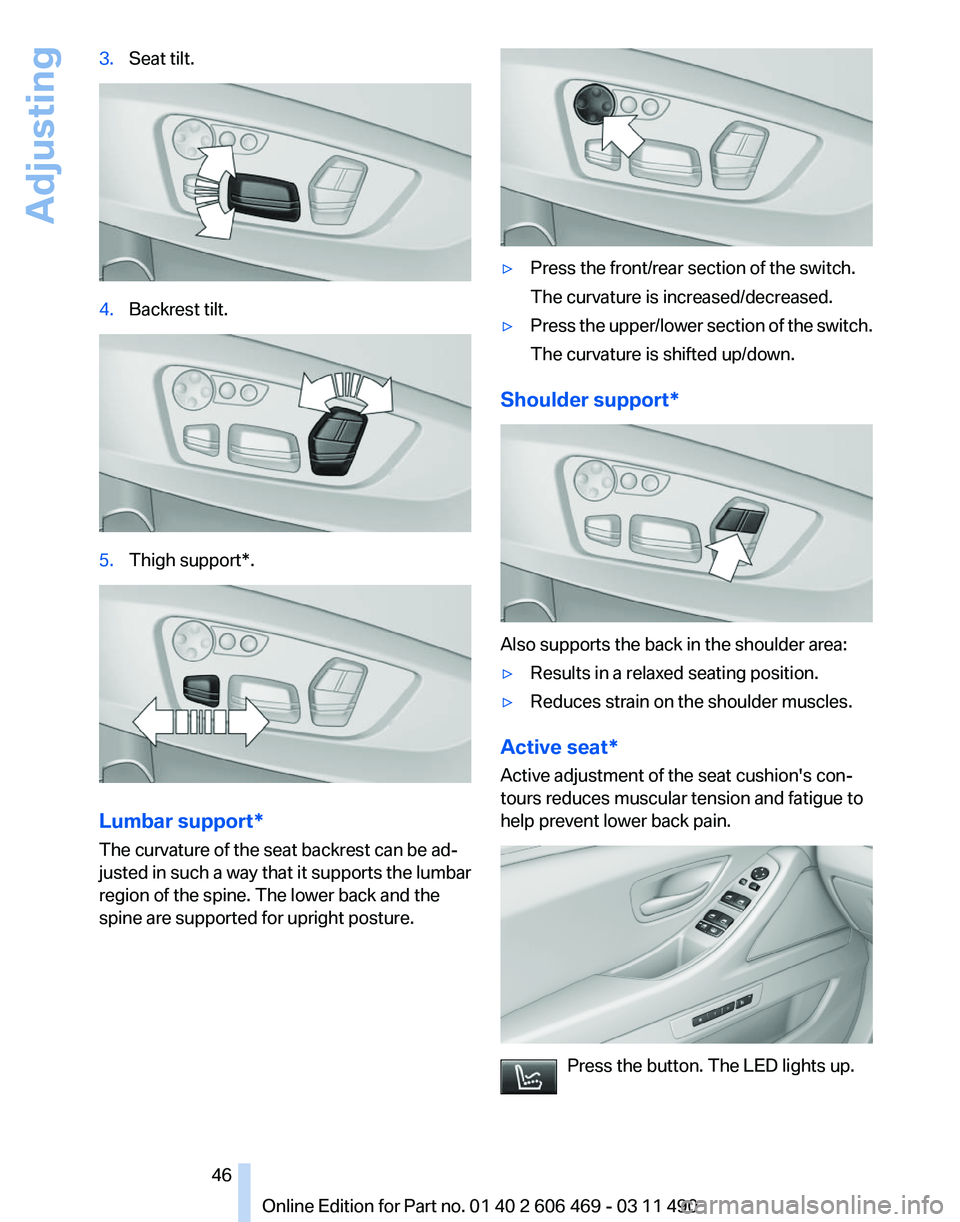
3.
Seat tilt. 4.
Backrest tilt. 5.
Thigh support*. Lumbar support*
The curvature of the seat backrest can be ad‚Äź
justed in such a way that it supports the lumbar
region of the spine. The lower back and the
spine are supported for upright posture. ‚Ė∑
Press the front/rear section of the switch.
The curvature is increased/decreased.
‚Ė∑ Press the upper/lower section of the switch.
The curvature is shifted up/down.
Shoulder support* Also supports the back in the shoulder area:
‚Ė∑
Results in a relaxed seating position.
‚Ė∑ Reduces strain on the shoulder muscles.
Active seat*
Active adjustment of the seat cushion's con‚Äź
tours reduces muscular tension and fatigue to
help prevent lower back pain. Press the button. The LED lights up. Seite 46
46 Online Edition for Part no. 01 40 2 606 469 - 03 11 490Adjusting
Page 48 of 304
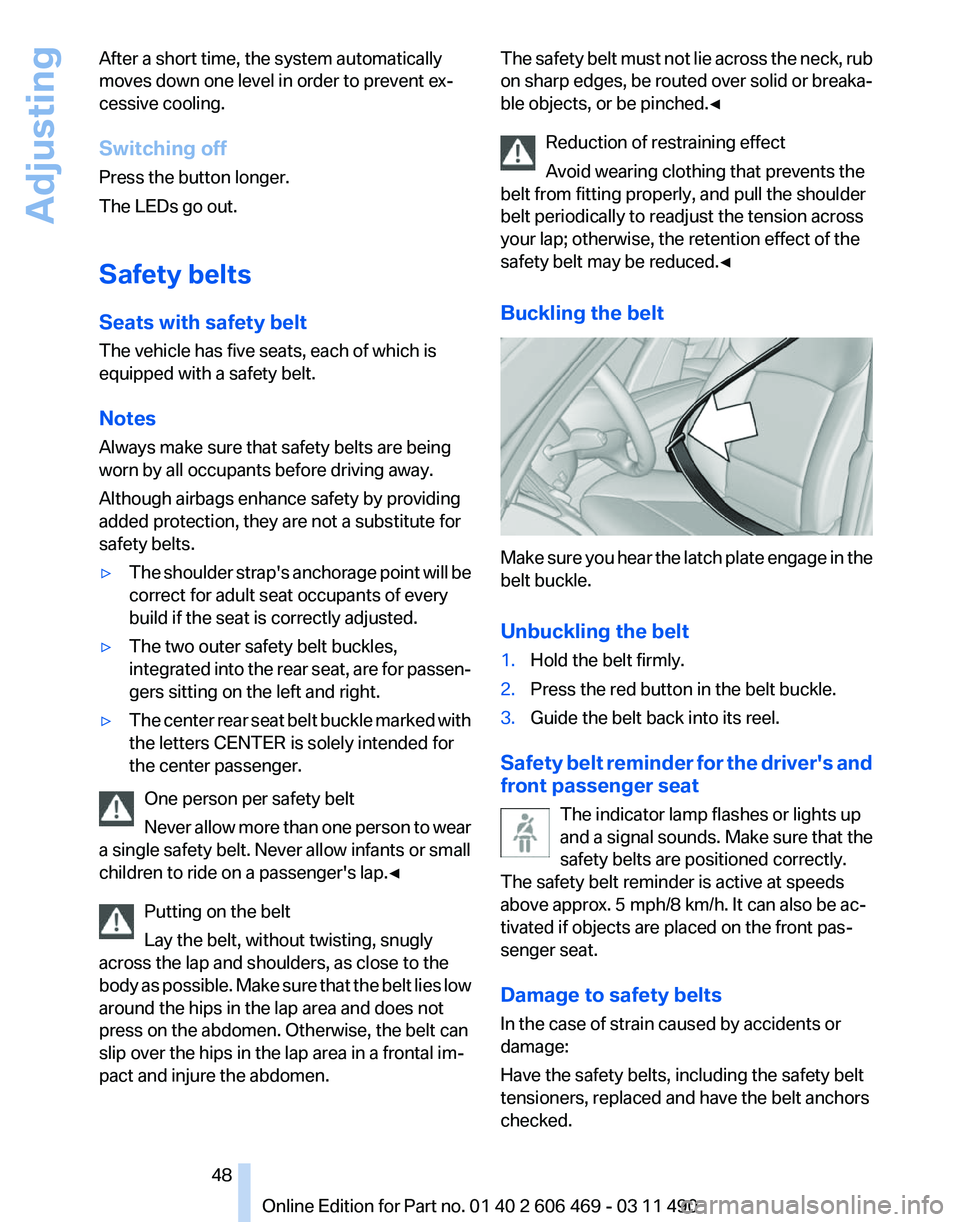
After a short time, the system automatically
moves down one level in order to prevent ex‚Äź
cessive cooling.
Switching off
Press the button longer.
The LEDs go out.
Safety belts
Seats with safety belt
The vehicle has five seats, each of which is
equipped with a safety belt.
Notes
Always make sure that safety belts are being
worn by all occupants before driving away.
Although airbags enhance safety by providing
added protection, they are not a substitute for
safety belts.
‚Ė∑
The shoulder strap's anchorage point will be
correct for adult seat occupants of every
build if the seat is correctly adjusted.
‚Ė∑ The two outer safety belt buckles,
integrated
into the rear seat, are for passen‚Äź
gers sitting on the left and right.
‚Ė∑ The center rear seat belt buckle marked with
the letters CENTER is solely intended for
the center passenger.
One person per safety belt
Never
allow more than one person to wear
a single safety belt. Never allow infants or small
children to ride on a passenger's lap.‚óÄ
Putting on the belt
Lay the belt, without twisting, snugly
across the lap and shoulders, as close to the
body as possible. Make sure that the belt lies low
around the hips in the lap area and does not
press on the abdomen. Otherwise, the belt can
slip over the hips in the lap area in a frontal im‚Äź
pact and injure the abdomen. The safety belt must not lie across the neck, rub
on
sharp edges, be routed over solid or breaka‚Äź
ble objects, or be pinched.‚óÄ
Reduction of restraining effect
Avoid wearing clothing that prevents the
belt from fitting properly, and pull the shoulder
belt periodically to readjust the tension across
your lap; otherwise, the retention effect of the
safety belt may be reduced.‚óÄ
Buckling the belt Make sure you hear the latch plate engage in the
belt buckle.
Unbuckling the belt
1.
Hold the belt firmly.
2. Press the red button in the belt buckle.
3. Guide the belt back into its reel.
Safety belt reminder for the driver's and
front passenger seat The indicator lamp flashes or lights up
and a signal sounds. Make sure that the
safety belts are positioned correctly.
The safety belt reminder is active at speeds
above approx. 5 mph/8 km/h. It can also be ac‚Äź
tivated if objects are placed on the front pas‚Äź
senger seat.
Damage to safety belts
In the case of strain caused by accidents or
damage:
Have the safety belts, including the safety belt
tensioners, replaced and have the belt anchors
checked. Seite 48
48 Online Edition for Part no. 01 40 2 606 469 - 03 11 490
Adjusting
Page 51 of 304
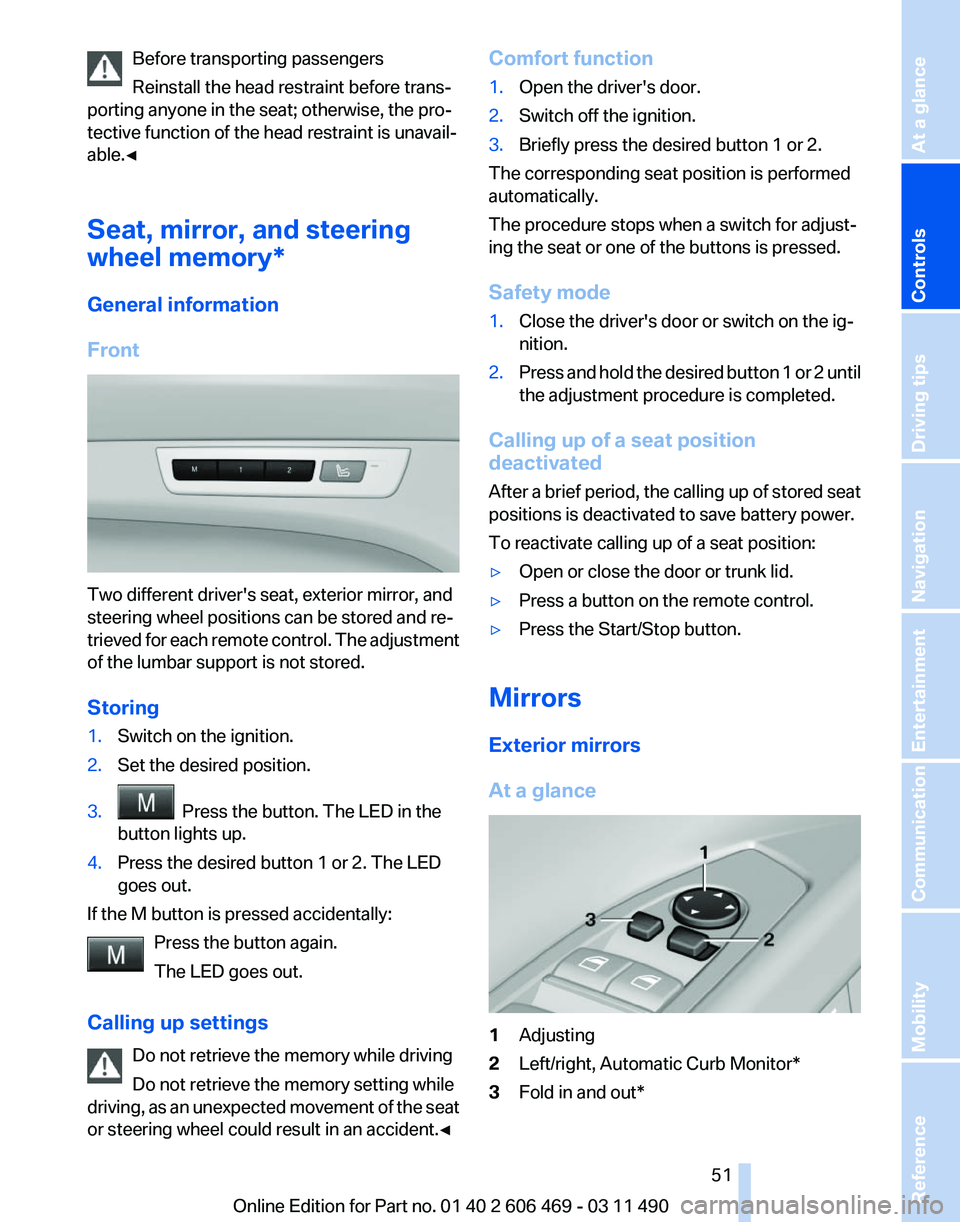
Before transporting passengers
Reinstall the head restraint before trans‚Äź
porting anyone in the seat; otherwise, the pro‚Äź
tective function of the head restraint is unavail‚Äź
able.‚óÄ
Seat, mirror, and steering
wheel memory*
General information
Front Two different driver's seat, exterior mirror, and
steering wheel positions can be stored and re‚Äź
trieved
for each remote control. The adjustment
of the lumbar support is not stored.
Storing
1. Switch on the ignition.
2. Set the desired position.
3. Press the button. The LED in the
button lights up.
4. Press the desired button 1 or 2. The LED
goes out.
If the M button is pressed accidentally: Press the button again.
The LED goes out.
Calling up settings Do not retrieve the memory while driving
Do not retrieve the memory setting while
driving,
as an unexpected movement of the seat
or steering wheel could result in an accident.‚óÄ Comfort function
1.
Open the driver's door.
2. Switch off the ignition.
3. Briefly press the desired button 1 or 2.
The corresponding seat position is performed
automatically.
The procedure stops when a switch for adjust‚Äź
ing the seat or one of the buttons is pressed.
Safety mode
1. Close the driver's door or switch on the ig‚Äź
nition.
2. Press and hold the desired button 1 or 2 until
the adjustment procedure is completed.
Calling up of a seat position
deactivated
After
a brief period, the calling up of stored seat
positions is deactivated to save battery power.
To reactivate calling up of a seat position:
‚Ė∑ Open or close the door or trunk lid.
‚Ė∑ Press a button on the remote control.
‚Ė∑ Press the Start/Stop button.
Mirrors
Exterior mirrors
At a glance 1
Adjusting
2 Left/right, Automatic Curb Monitor*
3 Fold in and out*
Seite 51
51Online Edition for Part no. 01 40 2 606 469 - 03 11 490
Reference Mobility Communication Entertainment Navigation Driving tips
Controls At a glance
Page 52 of 304
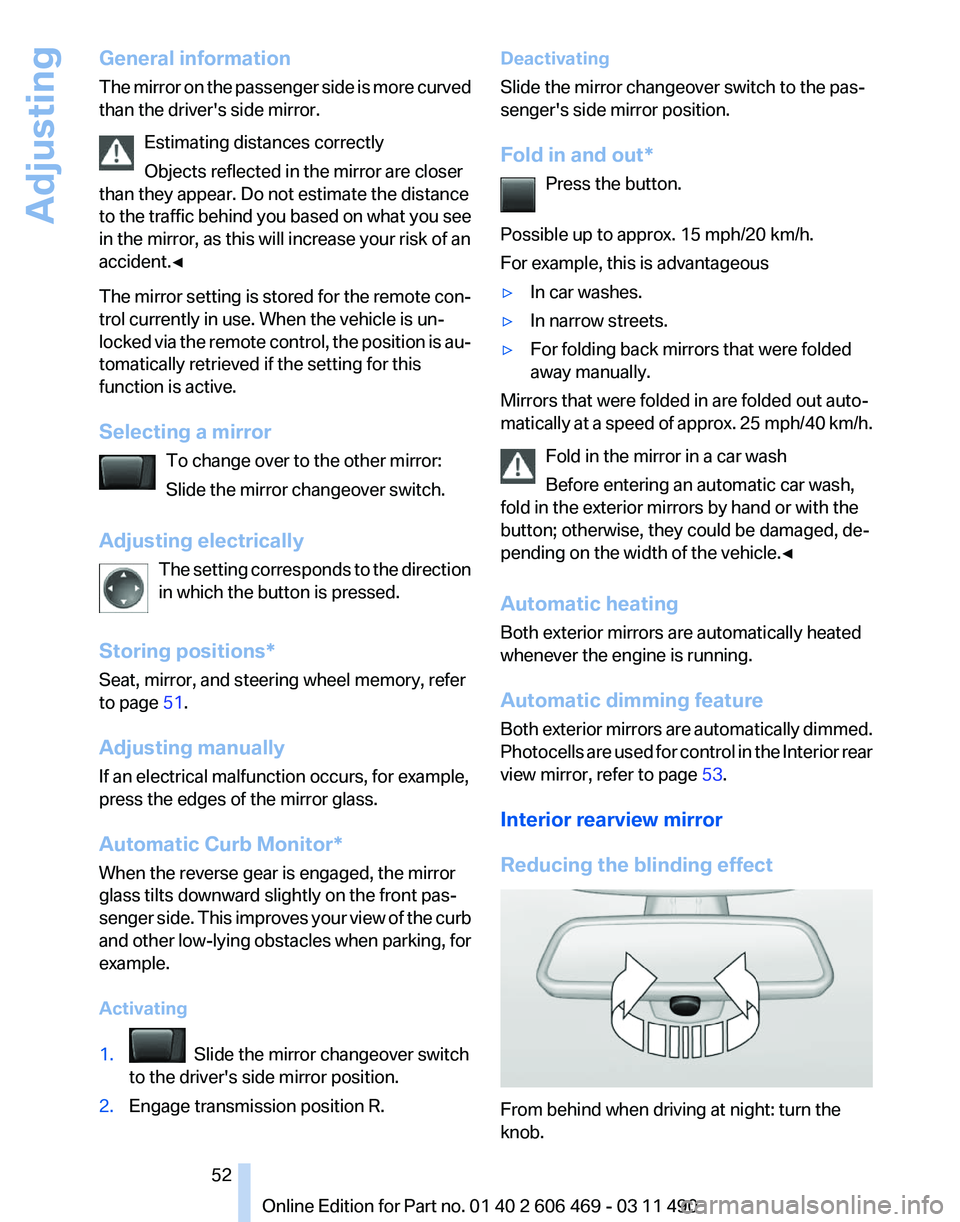
General information
The
mirror on the passenger side is more curved
than the driver's side mirror.
Estimating distances correctly
Objects reflected in the mirror are closer
than they appear. Do not estimate the distance
to the traffic behind you based on what you see
in the mirror, as this will increase your risk of an
accident.‚óÄ
The mirror setting is stored for the remote con‚Äź
trol currently in use. When the vehicle is un‚Äź
locked via the remote control, the position is au‚Äź
tomatically retrieved if the setting for this
function is active.
Selecting a mirror
To change over to the other mirror:
Slide the mirror changeover switch.
Adjusting electrically The setting corresponds to the direction
in which the button is pressed.
Storing positions*
Seat, mirror, and steering wheel memory, refer
to page 51.
Adjusting manually
If an electrical malfunction occurs, for example,
press the edges of the mirror glass.
Automatic Curb Monitor*
When the reverse gear is engaged, the mirror
glass tilts downward slightly on the front pas‚Äź
senger side. This improves your view of the curb
and other low-lying obstacles when parking, for
example.
Activating
1. Slide the mirror changeover switch
to the driver's side mirror position.
2. Engage transmission position R. Deactivating
Slide the mirror changeover switch to the pas‚Äź
senger's side mirror position.
Fold in and out*
Press the button.
Possible up to approx. 15 mph/20 km/h.
For example, this is advantageous
‚Ė∑ In car washes.
‚Ė∑ In narrow streets.
‚Ė∑ For folding back mirrors that were folded
away manually.
Mirrors that were folded in are folded out auto‚Äź
matically
at a speed of approx. 25 mph/40 km/h.
Fold in the mirror in a car wash
Before entering an automatic car wash,
fold in the exterior mirrors by hand or with the
button; otherwise, they could be damaged, de‚Äź
pending on the width of the vehicle.‚óÄ
Automatic heating
Both exterior mirrors are automatically heated
whenever the engine is running.
Automatic dimming feature
Both exterior mirrors are automatically dimmed.
Photocells are used for control in the Interior rear
view mirror, refer to page 53.
Interior rearview mirror
Reducing the blinding effect From behind when driving at night: turn the
knob. Seite 52
52 Online Edition for Part no. 01 40 2 606 469 - 03 11 490
Adjusting
Page 53 of 304
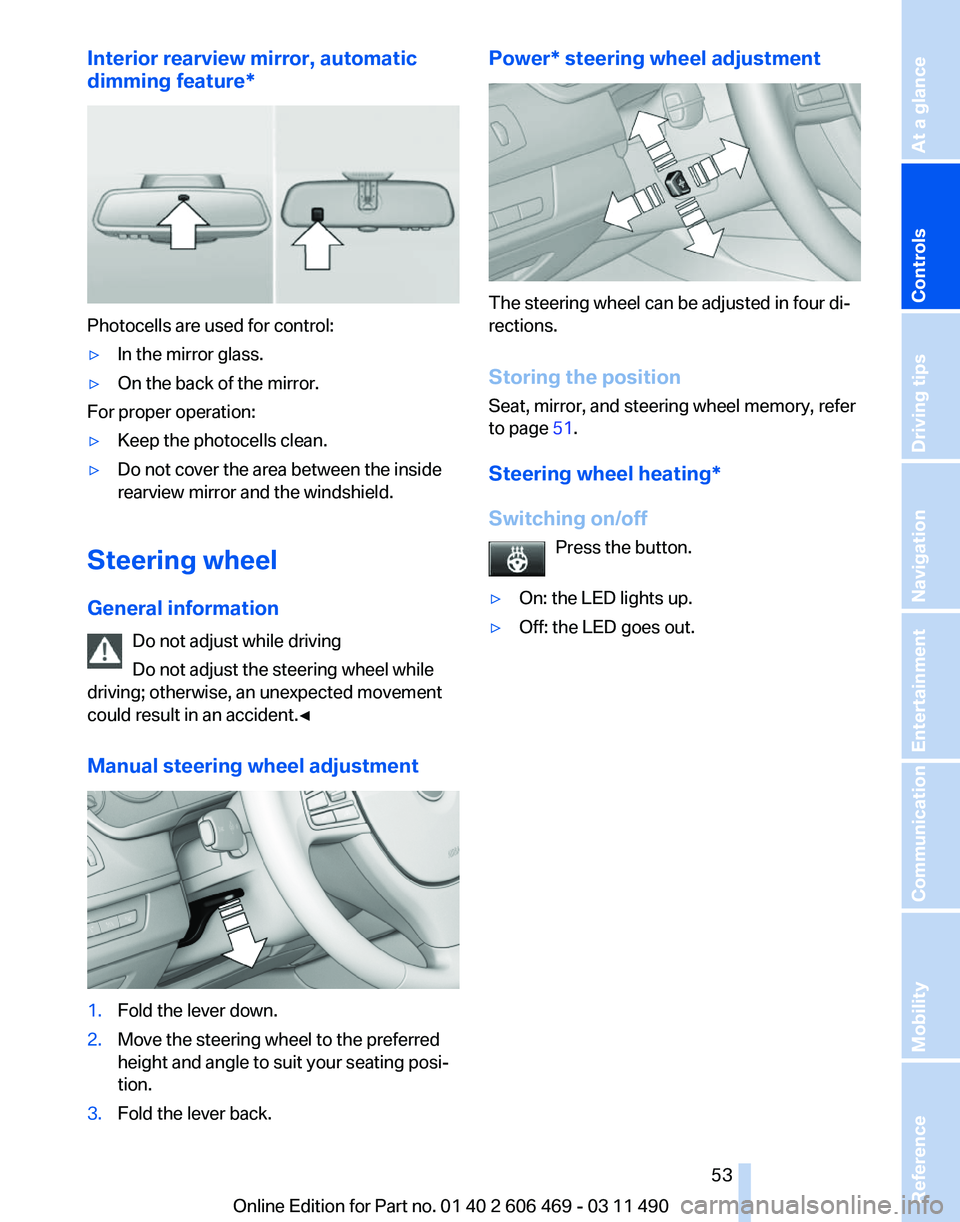
Interior rearview mirror, automatic
dimming feature
*Photocells are used for control:
‚Ė∑
In the mirror glass.
‚Ė∑ On the back of the mirror.
For proper operation:
‚Ė∑ Keep the photocells clean.
‚Ė∑ Do not cover the area between the inside
rearview mirror and the windshield.
Steering wheel
General information Do not adjust while driving
Do not adjust the steering wheel while
driving; otherwise, an unexpected movement
could result in an accident.‚óÄ
Manual steering wheel adjustment 1.
Fold the lever down.
2. Move the steering wheel to the preferred
height and angle to suit your seating posi‚Äź
tion.
3. Fold the lever back. Power* steering wheel adjustment
The steering wheel can be adjusted in four di‚Äź
rections.
Storing the position
Seat, mirror, and steering wheel memory, refer
to page
51.
Steering wheel heating
*
Switching on/off Press the button.
‚Ė∑ On: the LED lights up.
‚Ė∑ Off: the LED goes out. Seite 53
53Online Edition for Part no. 01 40 2 606 469 - 03 11 490
Reference Mobility Communication Entertainment Navigation Driving tips
Controls At a glance
Page 58 of 304
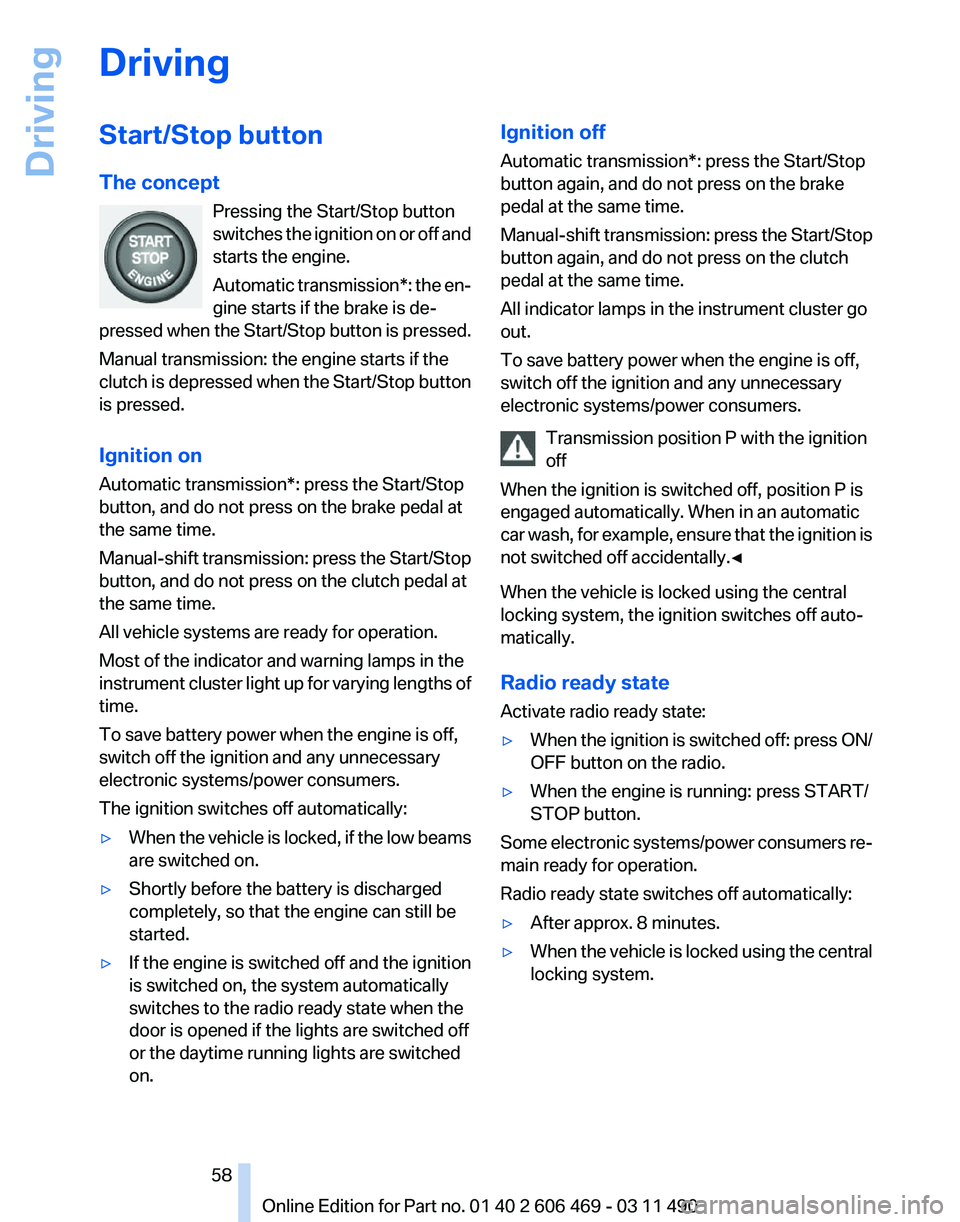
Driving
Start/Stop button
The concept
Pressing the Start/Stop button
switches
the ignition on or off and
starts the engine.
Automatic transmission*: the en‚Äź
gine starts if the brake is de‚Äź
pressed when the Start/Stop button is pressed.
Manual transmission: the engine starts if the
clutch is depressed when the Start/Stop button
is pressed.
Ignition on
Automatic transmission*: press the Start/Stop
button, and do not press on the brake pedal at
the same time.
Manual-shift transmission: press the Start/Stop
button, and do not press on the clutch pedal at
the same time.
All vehicle systems are ready for operation.
Most of the indicator and warning lamps in the
instrument cluster light up for varying lengths of
time.
To save battery power when the engine is off,
switch off the ignition and any unnecessary
electronic systems/power consumers.
The ignition switches off automatically:
‚Ė∑ When the vehicle is locked, if the low beams
are switched on.
‚Ė∑ Shortly before the battery is discharged
completely, so that the engine can still be
started.
‚Ė∑ If the engine is switched off and the ignition
is switched on, the system automatically
switches to the radio ready state when the
door is opened if the lights are switched off
or the daytime running lights are switched
on. Ignition off
Automatic transmission*: press the Start/Stop
button again, and do not press on the brake
pedal at the same time.
Manual-shift
transmission: press the Start/Stop
button again, and do not press on the clutch
pedal at the same time.
All indicator lamps in the instrument cluster go
out.
To save battery power when the engine is off,
switch off the ignition and any unnecessary
electronic systems/power consumers.
Transmission position P with the ignition
off
When the ignition is switched off, position P is
engaged automatically. When in an automatic
car wash, for example, ensure that the ignition is
not switched off accidentally.‚óÄ
When the vehicle is locked using the central
locking system, the ignition switches off auto‚Äź
matically.
Radio ready state
Activate radio ready state:
‚Ė∑ When the ignition is switched off: press ON/
OFF button on the radio.
‚Ė∑ When the engine is running: press START/
STOP button.
Some electronic systems/power consumers re‚Äź
main ready for operation.
Radio ready state switches off automatically:
‚Ė∑ After approx. 8 minutes.
‚Ė∑ When the vehicle is locked using the central
locking system. Seite 58
58 Online Edition for Part no. 01 40 2 606 469 - 03 11 490
Driving
Page 60 of 304
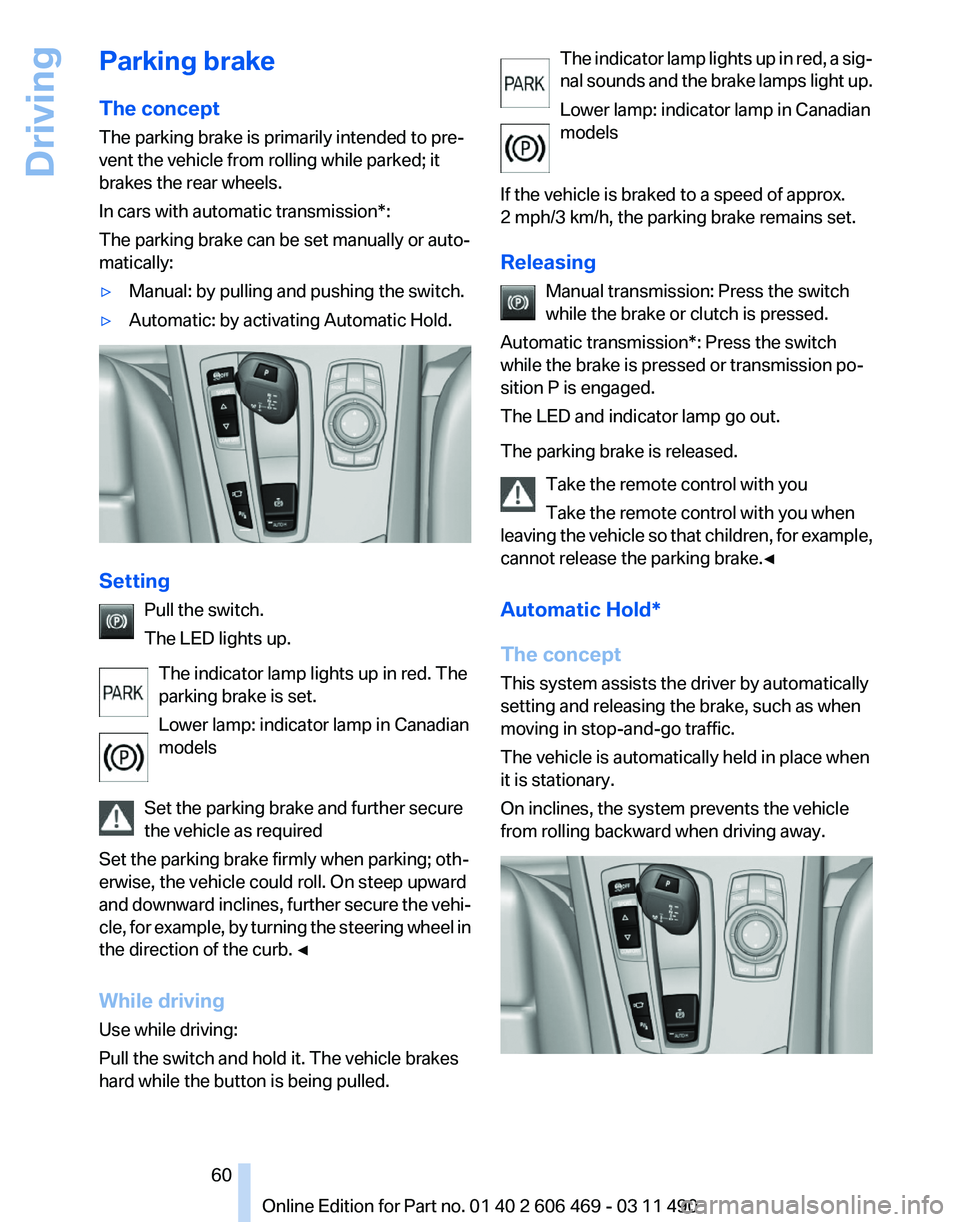
Parking brake
The concept
The parking brake is primarily intended to pre‚Äź
vent the vehicle from rolling while parked; it
brakes the rear wheels.
In cars with automatic transmission*:
The parking brake can be set manually or auto‚Äź
matically:
‚Ė∑
Manual: by pulling and pushing the switch.
‚Ė∑ Automatic: by activating Automatic Hold. Setting
Pull the switch.
The LED lights up.
The indicator lamp lights up in red. The
parking brake is set.
Lower lamp: indicator lamp in Canadian
models
Set the parking brake and further secure
the vehicle as required
Set the parking brake firmly when parking; oth‚Äź
erwise, the vehicle could roll. On steep upward
and
downward inclines, further secure the vehi‚Äź
cle, for example, by turning the steering wheel in
the direction of the curb. ‚óÄ
While driving
Use while driving:
Pull the switch and hold it. The vehicle brakes
hard while the button is being pulled. The indicator lamp lights up in red, a sig‚Äź
nal
sounds and the brake lamps light up.
Lower lamp: indicator lamp in Canadian
models
If the vehicle is braked to a speed of approx.
2 mph/3 km/h, the parking brake remains set.
Releasing Manual transmission: Press the switch
while the brake or clutch is pressed.
Automatic transmission*: Press the switch
while the brake is pressed or transmission po‚Äź
sition P is engaged.
The LED and indicator lamp go out.
The parking brake is released.
Take the remote control with you
Take the remote control with you when
leaving the vehicle so that children, for example,
cannot release the parking brake.‚óÄ
Automatic Hold*
The concept
This system assists the driver by automatically
setting and releasing the brake, such as when
moving in stop-and-go traffic.
The vehicle is automatically held in place when
it is stationary.
On inclines, the system prevents the vehicle
from rolling backward when driving away. Seite 60
60 Online Edition for Part no. 01 40 2 606 469 - 03 11 490
Driving
Page 61 of 304
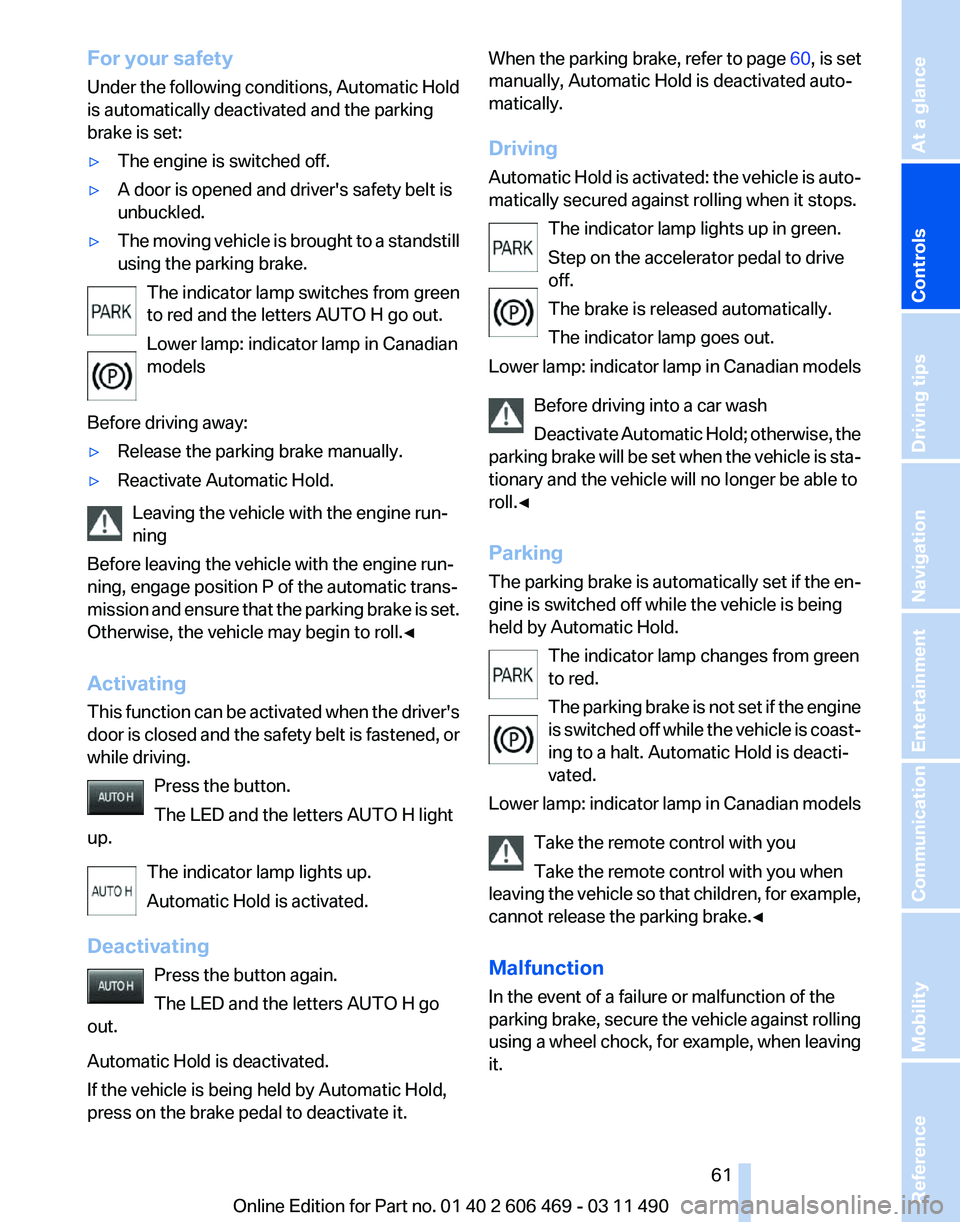
For your safety
Under
the following conditions, Automatic Hold
is automatically deactivated and the parking
brake is set:
‚Ė∑ The engine is switched off.
‚Ė∑ A door is opened and driver's safety belt is
unbuckled.
‚Ė∑ The moving vehicle is brought to a standstill
using the parking brake.
The indicator lamp switches from green
to red and the letters AUTO H go out.
Lower lamp: indicator lamp in Canadian
models
Before driving away:
‚Ė∑ Release the parking brake manually.
‚Ė∑ Reactivate Automatic Hold.
Leaving the vehicle with the engine run‚Äź
ning
Before leaving the vehicle with the engine run‚Äź
ning, engage position P of the automatic trans‚Äź
mission
and ensure that the parking brake is set.
Otherwise, the vehicle may begin to roll.‚óÄ
Activating
This function can be activated when the driver's
door is closed and the safety belt is fastened, or
while driving.
Press the button.
The LED and the letters AUTO H light
up.
The indicator lamp lights up.
Automatic Hold is activated.
Deactivating Press the button again.
The LED and the letters AUTO H go
out.
Automatic Hold is deactivated.
If the vehicle is being held by Automatic Hold,
press on the brake pedal to deactivate it. When the parking brake, refer to page
60, is set
manually, Automatic Hold is deactivated auto‚Äź
matically.
Driving
Automatic
Hold is activated: the vehicle is auto‚Äź
matically secured against rolling when it stops.
The indicator lamp lights up in green.
Step on the accelerator pedal to drive
off.
The brake is released automatically.
The indicator lamp goes out.
Lower lamp: indicator lamp in Canadian models
Before driving into a car wash
Deactivate Automatic Hold; otherwise, the
parking brake will be set when the vehicle is sta‚Äź
tionary and the vehicle will no longer be able to
roll.‚óÄ
Parking
The parking brake is automatically set if the en‚Äź
gine is switched off while the vehicle is being
held by Automatic Hold.
The indicator lamp changes from green
to red.
The parking brake is not set if the engine
is switched off while the vehicle is coast‚Äź
ing to a halt. Automatic Hold is deacti‚Äź
vated.
Lower lamp: indicator lamp in Canadian models
Take the remote control with you
Take the remote control with you when
leaving the vehicle so that children, for example,
cannot release the parking brake.‚óÄ
Malfunction
In the event of a failure or malfunction of the
parking brake, secure the vehicle against rolling
using a wheel chock, for example, when leaving
it. Seite 61
61Online Edition for Part no. 01 40 2 606 469 - 03 11 490
Reference Mobility Communication Entertainment Navigation Driving tips
Controls At a glance